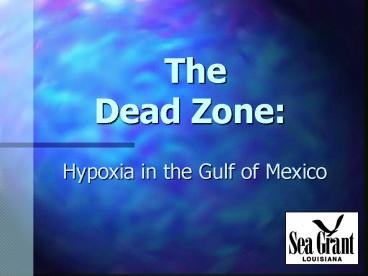The Dead Zone: PowerPoint PPT Presentation
1 / 50
Title: The Dead Zone:
1
The Dead Zone
- Hypoxia in the Gulf of Mexico
2
What is the dead zone?
3
Condition that occurs in coastal waters where
- Little or no oxygen is present
- Little or no marine life can survive
4
The term for low oxygen is hypoxia. Hypoxialt2
mg/l dissolved oxygen (DO)
5
The term for no oxygen is anoxia. Anoxia 0
mg/l dissolved oxygen
6
Where does hypoxia occur?
7
Hypoxia occurs all over the world in coastal
waters.
8
- Ireland
- Scotland
- Sweden
- Norway
- Finland
- Spain
- Germany
- Japan
- Hong Kong
- Australia
- New Zealand
- United States
- Canada
- France
- Italy
- Greece
- Turkey
- Russia
- Sea of Azov
- Adriatic Sea
- Aegean Sea
- Mediterranean Sea
9
(No Transcript)
10
In the U.S., hypoxia occurs in coastal waters in
New York, Maryland, North Carolina, Florida,
Alabama, Texas and Louisiana.
11
In Louisiana, the dead zone occurs west of the
Mississippi and Atchafalaya rivers
12
When does the dead zone occur?
13
In Louisiana, hypoxia occurs from late spring
until late summer.
14
Why is the dead zone a problem?
15
The dead zone can affect
Benthos Fisheries People
16
Benthos
- Stressed or die
- Decreased diversity
- Degraded environment
17
Fisheries
- Food base is reduced and/or lost
- Habitat is reduced and/or lost
- Recruitment is disrupted
- Migratory patterns are disrupted
- Species diversity is reduced
- Mortality increases
18
People
- Commercial fisheries
- Recreational fisheries
- Tourism
- Economy
19
The dead zone decreases the ability of the Gulf
to produce seafood. This affects the local
economy.
20
Louisiana has one of the largest coastal dead
zones in the world.
21
How large is Louisianas dead zone?
22
Since 1985, the dead zone has ranged in size from
about 100 square miles in 1988 to over 8,500
square miles in 2002.
23
The size of the dead zone depends upon the
conditions that cause it.
24
What causes hypoxia?
25
A combination of physical, chemical and
biological factors create conditions for hypoxia
in Louisiana.
26
Warm Temperatures
Warm spring and summer temperatures heat the
water surface.
27
O2
Calm seas decrease oxygen exchange at the
surface.
28
Nutrients
Warm fresh water and nutrients are delivered by
the Mississippi River and float on the denser
saltwater.
29
A stratified layer is formed with lighter,
fresher, warmer water at the surface and heavier,
saltier, cooler water near the bottom limiting
oxygen mixing throughout the water column.
Lighter Fresher Warmer Water
Stratified Layer
No O2 mixing
Heavier Saltier Cooler Water
30
The Mississippi River drains 41 of the lower 48
United States. It carries water and sediment
hundreds of miles to the Gulf of Mexico.
31
The Mississippi River also carries nutrients.
32
Excess nutrients from runoff are carried to the
Gulf of Mexico.
33
Nutrients include compounds which contain
Phosphorus Nitrogen Silica
34
Nutrients that are carried by the river come from
a variety of sources.
35
Municipal industrial runoff
Atmosphere
Fertilizers
Cattle, pig and poultry farm runoff
Wastewater treatment
36
Microscopic algae or phytoplankton use these
nutrients to reproduce.
37
Excess nutrients enable plankton populations to
explode, causing a plankton or algal bloom.
38
At the surface, plankton blooms occur when excess
nutrients are present
Plankton bloom
39
When plankton die, they sink and decompose
40
When plankton die, they sink to the bottom and
decompose.
During decomposition bacteria use up most or all
of the available oxygen.
Dead Plankton
No O2
Decomposers
41
During decomposition, bacteria use up most or all
of the oxygen causing the water column to become
hypoxic or anoxic.
42
Mobile animals become stressed and leave
Stationary animals become stressed and/or die
43
When little or no oxygen is present
- Mobile animals leave.
- Stationary animals become stressed or die.
44
Warm Temperatures
Fresh River Water
Nutrients
O2
Plankton Bloom
Lighter, Fresher, Warmer, Water
Dead Plankton
Stratified Layer
No O2 Mixing
Heavier, Saltier, Cooler, Water
No O2
Decomposers
45
(No Transcript)
46
Human activities contribute to the causes of
hypoxia
47
Land use practices Fertilizer use Poor
management practices
48
Changes in land use from
Agriculture Industry Flood control Urban
expansion Lead to Loss of natural habitat
49
What can be done?
50
- Change flood control practices
- Use fertilizers more efficiently
- Control discharges of nitrogen
- Create and restore wetlands
- Reduce nutrient loading
- Manage the whole system

